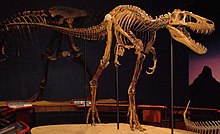Nanotyrannus
| Nanotyrannus | ||||||||||||
|---|---|---|---|---|---|---|---|---|---|---|---|---|

Cast of the skull of "Jane" in the Burpee Museum of Natural History |
||||||||||||
| Temporal occurrence | ||||||||||||
| Upper Cretaceous ( Maastrichtian ) | ||||||||||||
| 72 to 66 million years | ||||||||||||
| Locations | ||||||||||||
|
||||||||||||
| Systematics | ||||||||||||
|
||||||||||||
| Scientific name | ||||||||||||
| Nanotyrannus | ||||||||||||
| Bakker , Currie & Williams, 1988 | ||||||||||||
| Art | ||||||||||||
|
Nanotyrannus ("little tyrann", from Greek nanos "dwarf" and tyrannos "king, tyrant") is the generic name of theropod dinosaurs , which are assigned to the family of Tyrannosauridae , which at the end of the Cretaceous period about 72 to 66 million years ago ( Maastrichtium ) lived in western North America .
Like all tyrannosaurids, Nanotyrannus was also a bipedal carnivore , but with a length of five meters it was significantly smaller than its relatives. An isolated skull ( type material ) of this genus was discovered as early as 1942; a more complete partial skeleton, called "Jane", discovered researchers in 2001. Both finds come from the Hell Creek Formation of Montana , so that Nanotyrannus shared its habitat with the much larger Tyrannosaurus rex . Many paleontologists today suspect that Nanotyrannus is a young animal of the Tyrannosaurus ( juvenile synonym). Recent studies support this assumption that the taxon nanotyrannus would therefore be invalid.
History of discovery and research
The type specimen discovered in 1942 (catalog number CMN 7541), a small skull, was originally attributed to Gorgosaurus lancensis (now known as Albertosaurus ) by Charles W. Gilmore in 1946 . Robert T. Bakker , Phillip Currie and Michael Williams re-described the find in 1988 and concluded that the cranial bones were fused, suggesting an adult animal. This research group created a new genus, which they named Nanotyrannus because of its small size . However, other researchers questioned this assignment and often assume that Nanotyrannus is a juvenile Tyrannosaurus rex . The skull is on display today at the Cleveland Museum of Natural History .
In 2001, a group of researchers at the Burpee Museum of Natural History discovered a more complete, 50% preserved specimen of Nanotyrannus , nicknamed "Jane" (catalog number BMRP 2002.4.1.). The find consists of a complete, 57.2 cm long skull as well as other skeletal material (post cranium). "Jane" is on display for the public today at the Burpee Museum. At a conference held at the Burpee Museum on the validity of Nanotyrannus , many paleontologists such as Phillip Currie and Donald Henderson saw the new discovery as confirmation that Nanotyrannus was indeed a juvenile Tyrannosaurus rex or a closely related one Kind of had to act. Peter Larson, on the other hand, continued to support a separate genus for nanotyrannus . It has been speculated that Nanotyrannus may have hunted in packs, thus the teeth of various Nanotyrannus individuals were discovered in the bones of herbivorous dinosaurs.
In a 2020 study published in Science Advances , researchers revealed a detailed analysis of bone cross-sections of juvenile Tyrannosaurus . The results suggest that Tyrannosaurus growth rates varied with age and that the species appeared to be able to slow their growth when food was scarce, which may have given them an evolutionary advantage. Some of the Nanotyrannus bones examined in this way confirmed that they were indeed juveniles. Nanotyrannus was either larger than previously thought, or - what the researchers believe is much more likely - the fossils belong to young tyrannosaurus .
Web links
Individual evidence
- ↑ Ben Creisler: Dinosauria Translation and Pronunciation Guide N. In: Dinosauria On-Line. Archived from the original on January 22, 2010 ; accessed on July 29, 2008 (English).
- ^ A b Holly N. Woodward, Katie Tremaine, Scott A. Williams, Lindsay E. Zanno, John R. Horner: Growing up Tyrannosaurus rex: Osteohistology refutes the pygmy “Nanotyrannus” and supports ontogenetic niche partitioning in juvenile Tyrannosaurus . In: Science Advances . tape 6 , no. 1 , January 1, 2020, ISSN 2375-2548 , p. eaax6250 , doi : 10.1126 / sciadv.aax6250 ( sciencemag.org [accessed February 14, 2020]).
- ^ Charles W. Gilmore : A new carnivorous dinosaur from the Lance Formation of Montana (= Smithsonian Miscellaneous Collections. Vol. 106, No. 13, ISSN 0096-8749 = Smithsonian Institution. Publication. 3857). Smithsonian Institution, Washington DC 1946, digitized .
- ^ Robert T. Bakker , Michael Williams, Philip J. Currie : Nanotyrannus, a new genus of pygmy tyrannosaur, from the latest Cretaceous of Montana. In: Hunteria. Vol. 1, No. 5, 1988, ZDB -ID 1251702-1 , pp. 1-30.
- ↑ Philip J. Currie, Jørn H. Hurum, Karol Sabath: Skull structure and evolution in tyrannosaurid dinosaurs . In: Acta Palaeontologica Polonica. Vol. 48, No. 2, 2003, ISSN 0567-7920 , pp. 227-234, (PDF; 137 kB).
- ↑ Philip J. Currie, Mike Henderson, Jack R. Horner, Scott A. Williams: On tyrannosaur teeth, tooth positions and the taxonomic status of Nanotyrannus lancensis. In: The origin, systematics, and paleobiology of Tyrannosauridae. A Symposium hosted jointly by Burpee Museum of Natural History and Northern Illinois University. Abstracts 2005. p. 19.
- ↑ Donald Henderson: Nano No More: The death of the pygmy tyrant. In: The origin, systematics, and paleobiology of Tyrannosauridae. A Symposium hosted jointly by Burpee Museum of Natural History and Northern Illinois University 2005. Abstracts. P. 17.
- ↑ Peter Larson: A case for Nanotyrannus. In: The origin, systematics, and paleobiology of Tyrannosauridae. A Symposium hosted jointly by Burpee Museum of Natural History and Northern Illinois University 2005. Abstracts. P. 18.
- ^ Karen Nordquist: Karen's Comments. 2004, accessed March 11, 2007 .
